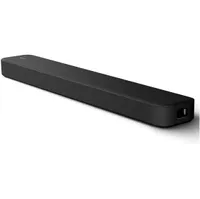What Hi-Fi? Verdict
Almost three years since its launch, the Sonos Ray remains one of the best budget soundbars available, particularly if crisp and clear dialogue is your priority. There are rivals that offer meatier sound and more features, though.
Pros
- +
Excellent vocal clarity
- +
Punchy, forthright projection
- +
Detailed high end
Cons
- -
Not much low-end extension
- -
Delivery a touch clinical
- -
Narrow soundfield
Why you can trust What Hi-Fi?
Whether you’re in the market for designer clothing, lifestyle tech or bespoke furniture, hunting down luxury items on a budget is no easy task during the best of times. And at the worst of times? Even a rummage around TK Maxx can yield little more than some knock-off AirPods and a chipped Le Creuset ramekin.
We’re becoming so conditioned to seeing prices for high-end goods rise while quality often drops that when we initially heard rumours that premium electronics brand Sonos was releasing its first budget soundbar, the Sonos Ray, we couldn’t help but wonder, what’s the catch?
Sonos has always had an aspirational cachet. Its elegantly crafted but expensive speakers are developed to be used en masse, integrating to provide you with an expansive, seamless audio accompaniment in every part of your home as well as immersive cinema sound in your living room. Can the Sonos Ray still deliver something approaching this experience at an accessible price?
Price

- The cheapest Sonos soundbar by quite a margin
- Can be expanded through the addition of surround speakers and/or a subwoofer
Sitting at the bottom of Sonos' three-strong soundbar line-up, the Sonos Ray is the brand's most affordable TV soundbar ever, priced at £279 / $279 / AU$399. Above it is the Sonos Beam Gen 2, which launched last year at £449 / $449 / AU$699 and features virtual Dolby Atmos.
Unlike the Sonos Beam Gen 2, the Ray does not have eARC connectivity, instead sporting only an optical input. That means that it cannot decode Dolby Atmos – audio format support is limited to Stereo PCM, Dolby Digital 5.1, and DTS Digital Surround, with confirmation of the codec type displayed on the app's 'Now Playing' page. Of course, being a Sonos product, the Ray does still, however, include network support and Airplay for wireless multi-room playback.
It’s fairly unusual to find wi-fi connectivity in an entry-level soundbar, and while many soundbars costing similar money to the Ray – such as the Majority Sierra Plus, which costs £270 / $300 (around AU$470) – have HDMI ports and even Dolby Atmos support, streaming is typically strictly limited to Bluetooth which, incidentally, the Ray does not have.
While it's the only non-Dolby Atmos soundbar in the current Sonos range, the Ray nonetheless offers users the flexibility to create a standard multi-channel surround system that can be added to over time.
The latest hi-fi, home cinema and tech news, reviews, buying advice and deals, direct to your inbox.
Options to expand the Sonos Ray include adding two One SL rear speakers (£358 / $358 / AU$538) and the pricey Sonos Sub (£699 / $699 / AU$999). However, it's unlikely customers will want to pay nearly four times the price of the soundbar for surround separates. Instead, Sonos envisions the Ray partnering with the more affordable Symfonisk IKEA rage, which features the Symfonisk bookshelf speaker £99 / $99 (around AU$176) and Symfonisk lamp, starting at £159 / $140 / AU$269. While Symfonisk doesn’t yet include a subwoofer, there are unconfirmed rumours that Sonos will release a new sub that’s both size and price compatible with the Ray, which would likely be a welcome addition to most users.
Design and build quality
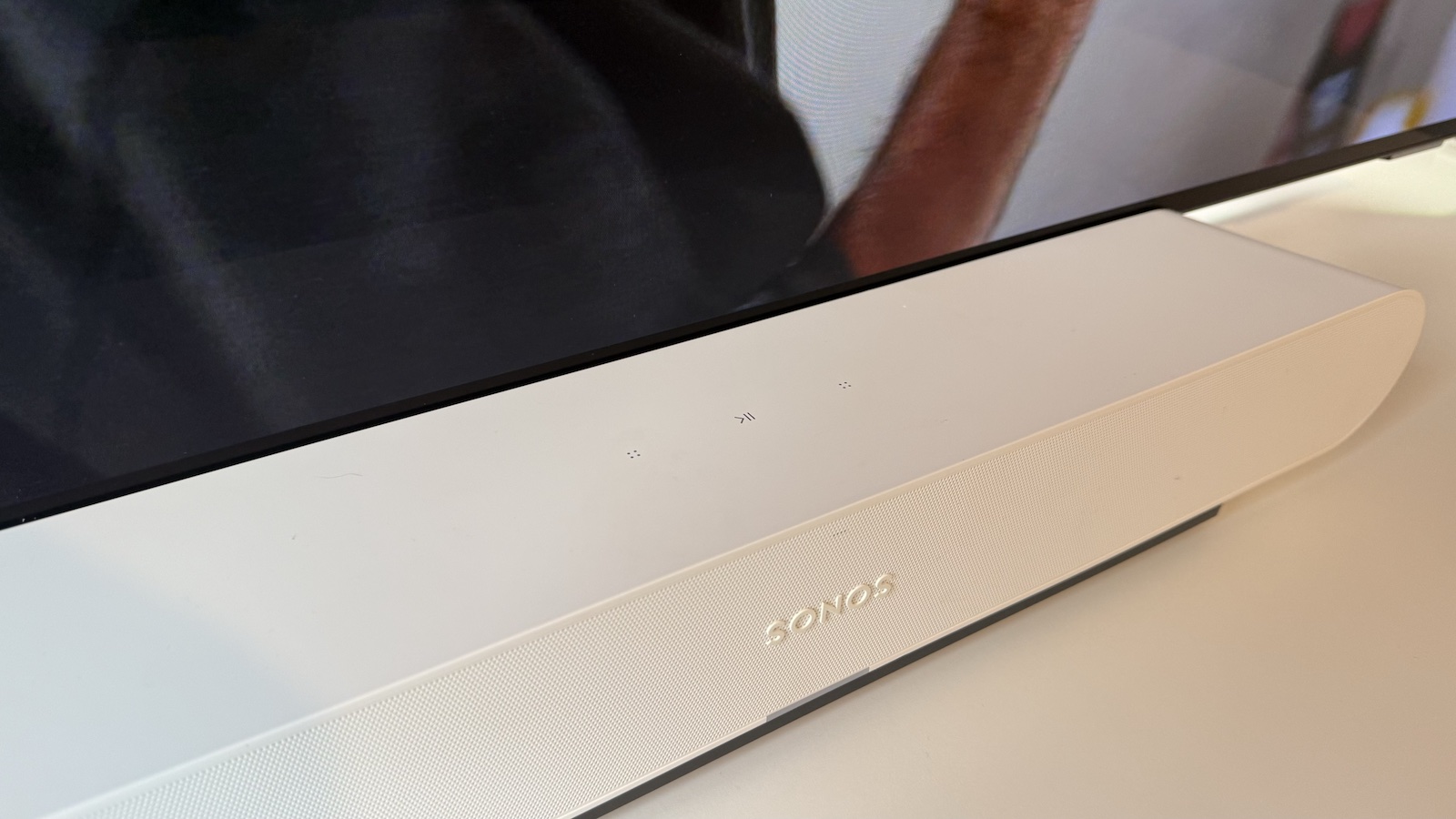
- Ultra-compact. tapered design fits beneath most TVs
- No Dolby Atmos processing so can be placed in a nook
The Ray marks something of a departure for Sonos. It still maintains the company's core identity of interoperability, allowing it to form part of a wireless multi-room system using Apple AirPlay 2, Spotify Connect, Tidal Connect and/or the Sonos S2 app. But this is a speaker aimed at those who have likely never considered the brand before. Its ultra-compact dimensions, tapered build and forward-facing speakers mean it takes up little space and removes any need for a clear line of sight for upward- and side-firing drivers, making it a practical choice for small rooms or shared spaces.
Aesthetically the Ray is very much part of the rarified Sonos gene pool with soft curves, capacitive touch buttons, monochrome finishes and a perforated polycarbonate grille. The grille's edge doesn’t sit completely flush with the main body in either of the product samples that were supplied for this review, but while that’s unusual for a company as typically fastidious as Sonos, it’s a minor quibble in what is otherwise a very smart-looking speaker at this price point.
Features
- No HDMI port – TV is connected via bundled optical cable
- Full Sonos music streaming capabilities
- No built-in voice control
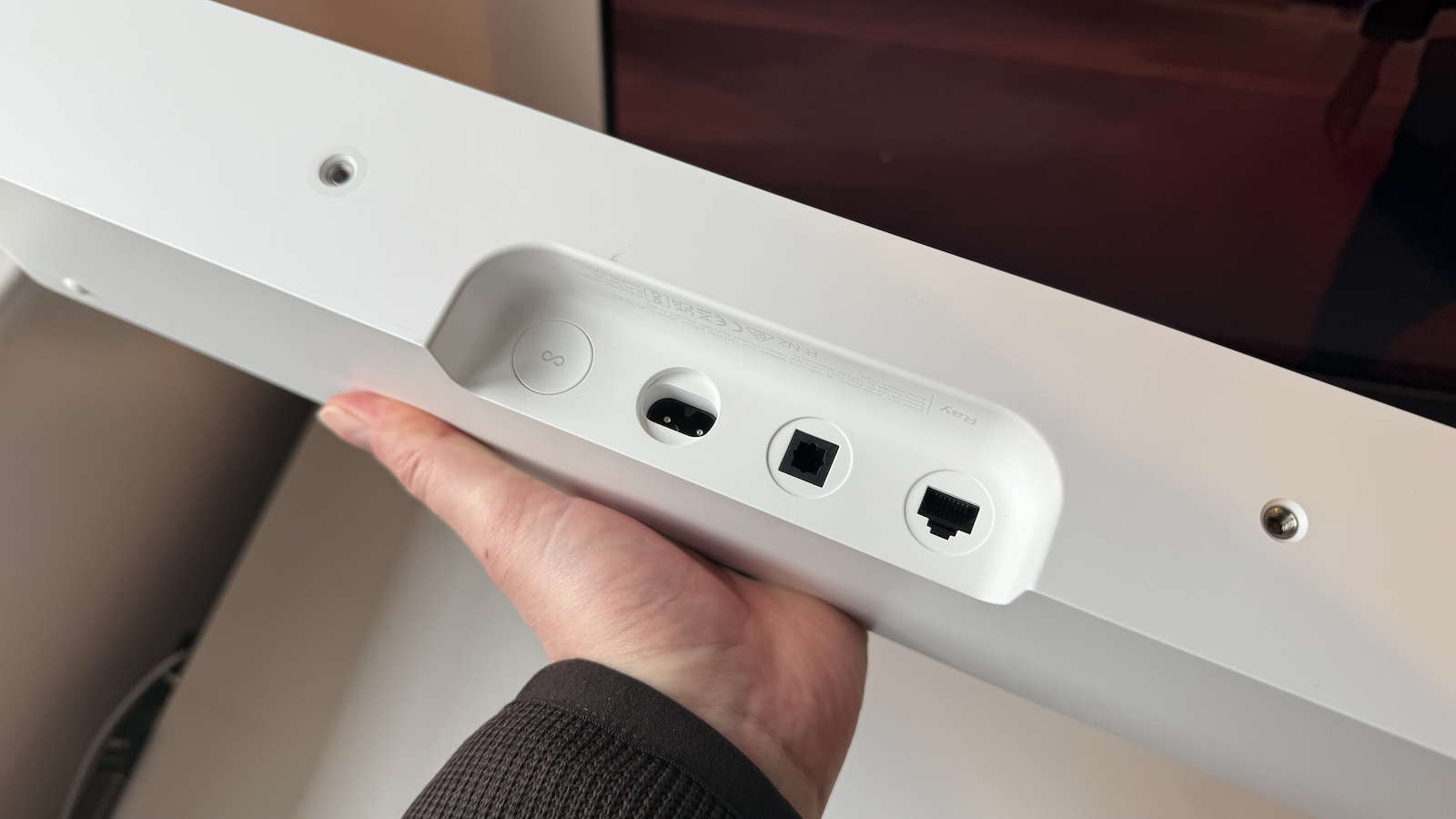
Inside sit a quartet of class D amplifiers powering the Ray's array of four forward-facing drivers – two centrally positioned elliptical mid-woofers flanked by a pair of tweeters that fire into split waveguides. The waveguides separate and disperse high frequencies forwards and outwards for a sense of spaciousness that in conjunction with the Ray's audio processing, Sonos claims, will create a wide soundstage and help to locate effects accurately within your room. While Sonos has said the Ray could be described as a 3.0 system, there is no dedicated centre channel driver, with all of the drivers instead sharing dialogue duties.
Low frequencies are handled by proprietary low-velocity curved bass reflex ports that Sonos says deliver a weighty low end without distortion, thanks to a design that controls the airflow speed inside to reduce drag-induced turbulence. We’ve always been impressed with how well Sonos can overcome the limitations of scale when it comes to producing a meaty sound, and although, unsurprisingly, the diminutive Ray doesn't serve up particularly meaty bass, since a post-launch firmware update addressed some of our initial concerns, said bass is well controlled and free from unwanted resonance.
As the Ray has been conceived to neatly slot into cabinets without its sonic dispersion being impacted, it doesn’t feature the virtual Dolby Atmos decoding of Sonos’ more premium soundbars – the Beam Gen 2, Arc and Arc Ultra. So, pragmatically, Sonos has also decided to ditch the HDMI eARC connections of its pricier products in favour of a classic optical input, reasoning that since this speaker isn’t intended to handle high bitrate immersive formats, it doesn’t then need the requisite port.
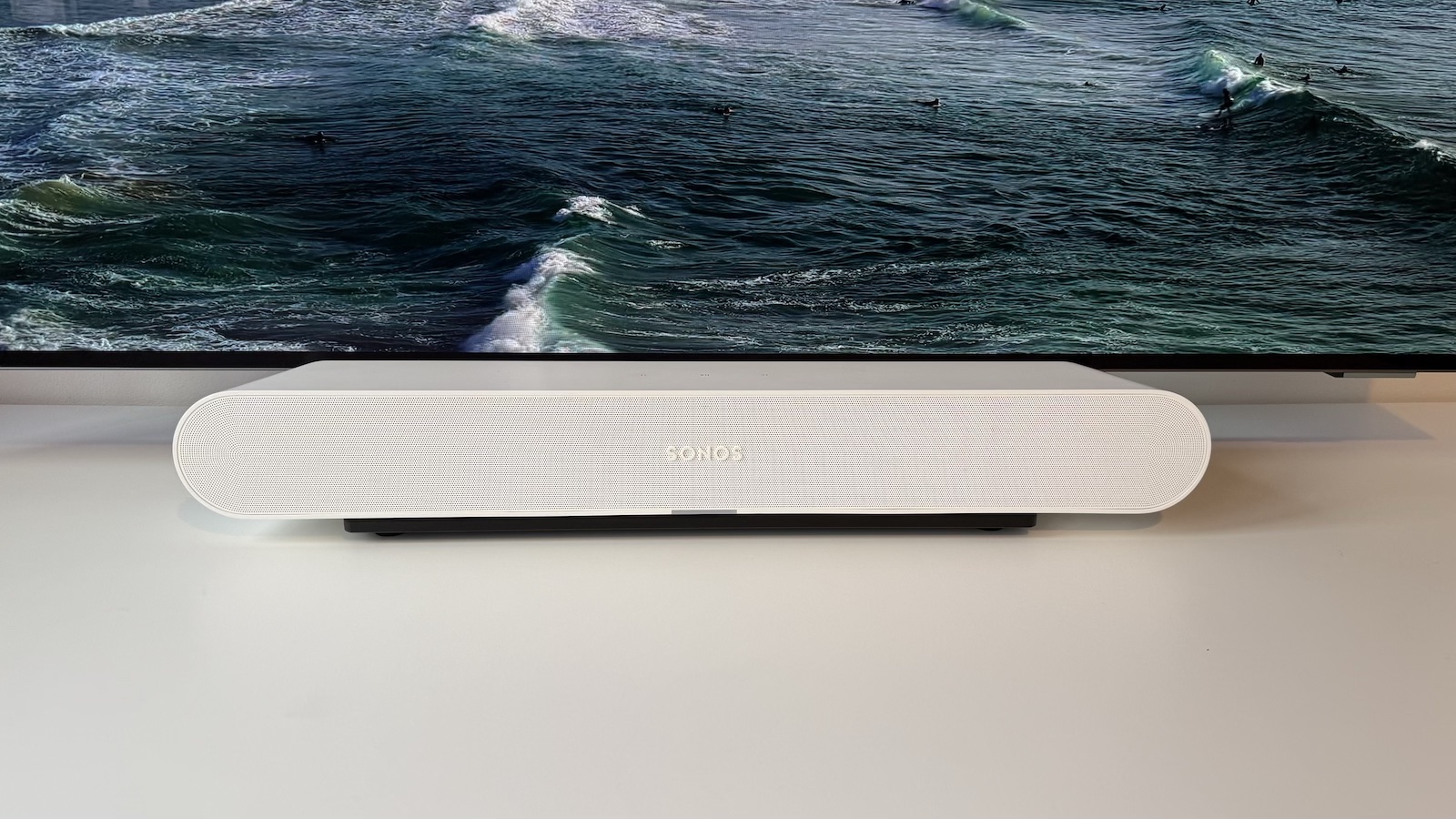
Connections 1 x optical
Sound formats Stereo PCM, Dolby Digital 5.1 and DTS Digital Surround
Bluetooth No
Wi-fi? Yes, with streaming via Airplay2, Spotify Connect and Tidal Connect
Finishes Black matte, white matte
Dimensions (hwd) 7 x 56 x 10cm
Weight 2.8kg
Given that even Sonos’ now discontinued Beam Gen 1 sported ARC, we’re a bit disappointed that the Ray has been downgraded in this way, as having HDMI on a non-Atmos product isn’t entirely a superfluous affectation, in part because it allows you to easily use your regular remote to control a soundbar's functions. To overcome this, the Sonos Ray has an infra-red receiver that will allow the soundbar to sync with your TV remote. The process is very simple for a typical IR remote using the Sonos app, though if you have an RF remote (e.g. an LG Magic Remote), you’ll also have to delve into your TV's menu settings.
More significantly, it’s a shame that the Ray doesn’t include HDMI ARC/eARC connectivity as it seems to have obvious potential as a desktop speaker, particularly for gaming. At 7cm high and 56cm wide, the Ray is ideally sized to sneak beneath a monitor. Although many people use TVs as gaming displays and will likely, therefore, have an optical output they can use, there are plenty who use dedicated monitors that don't handle sound at all and, thanks to an increasing lack of optical outputs built into consoles and PCs, these gamers won’t easily be able to take advantage of the Ray’s clever design and spirited delivery.
Another notable feature from the rest of Sonos' soundbar range absent from the Ray is in-built microphones, so direct voice control is not an option here. It does boast all of the standard in-app functionality you’d expect from any Sonos product, though, such as an adjustable two-band EQ, a speech enhancement mode to help clarify dialogue and a night mode that compresses the soundbar's dynamic range for listening at quieter volumes.
Perhaps the most helpful app-supported feature on-board is Trueplay, Sonos' room calibration software that uses the mic on a supported iOS device to measure the acoustics of your room and optimise the soundbar's response accordingly. This has always been a worthwhile endeavour with Sonos products and is a welcome and decidedly high-end feature to find in a product at this price.
Sound quality
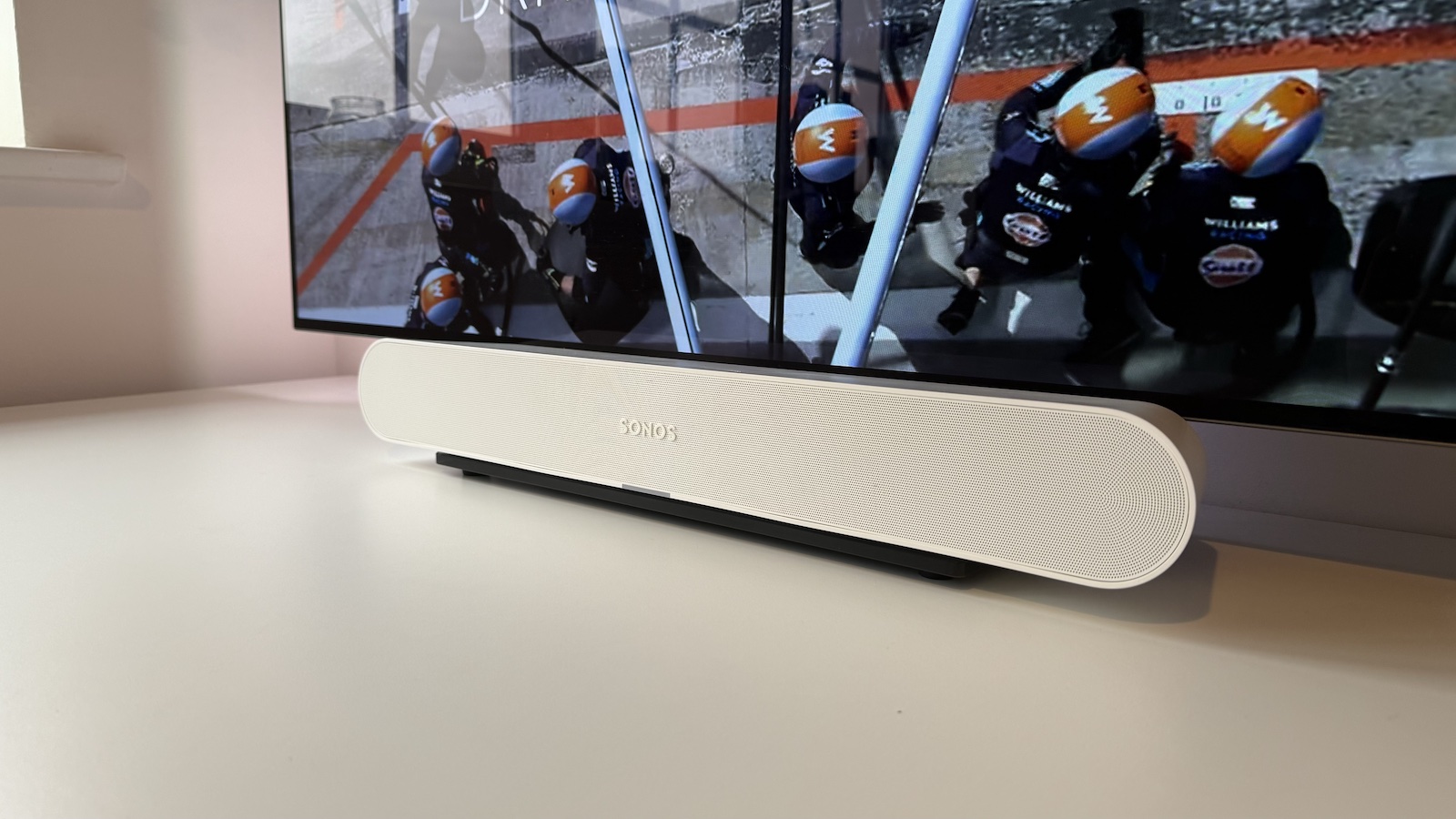
- Crisp, clear dialogue
- Attacking, exciting delivery
- Sound lacks the warmth of rivals and its siblings
Starting off with Blade Runner 2049 we're pleased to discover that in many ways the Sonos Ray does well for an affordable soundbar. As K makes his way to his baseline test in chapter 2, the clangorous soundscape and snatches of dialogue are clear and forthright, altogether avoiding the boxiness often heard with other budget soundbars. Although there isn’t quite as much authenticity and warmth in voices as the Beam Gen 2 can offer, speech is pleasantly crisp without veering into harshness.
During the baseline interview itself, there’s some sense of the cramped, reflective space that K is sitting in and the relative location of the interviewer's disembodied voice; however, the imaging is, as is to be expected given the Ray’s dimensions, relatively narrow. This means that as Spinners whizz by, there isn’t the same sweep and sense of motion across the soundstage that we might expect from more premium products.
Switching to O Brother, Where Art Thou?, where the southern drawl of the main characters can often cause intelligibility issues, the Ray once again delivers, allowing us to easily enjoy the savvy and surreal script as well as the actors’ performances.
While the Ray is surprisingly detailed for a budget soundbar, compared to the Sonos Beam Gen 2 we find it slightly dampens competing background effects in favour of vocal presentation. This means that sounds such as the countryside cicadas or the transient clanks of the chains that connect the escaping convicts are a touch recessed, resulting in an overall performance that is a little flat and one-dimensional. However, given the compromises that have to be made when producing a multi-use speaker of this proportion and price, we feel that Sonos has made the right choice here to prioritise voices, as this will likely be the primary concern of most users.
And, of course, compared to the amount of subtle nuance that is regularly missed from films when listening only to a TV’s in-built speakers, the Ray certainly offers a far greater level of enhancement. Streaming The Dig on Netflix, the Ray is able to pick out the gentle humming of the Suffolk countryside in the summer, significantly adding to the film's dreamy ambience. During the storm scene, as a gruff Ralph Fiennes hurriedly tries to secure the dig site, his exchange with Carey Mulligan's character is effortlessly audible, while the dripping and splashing of the sudden downpour is nicely textured.
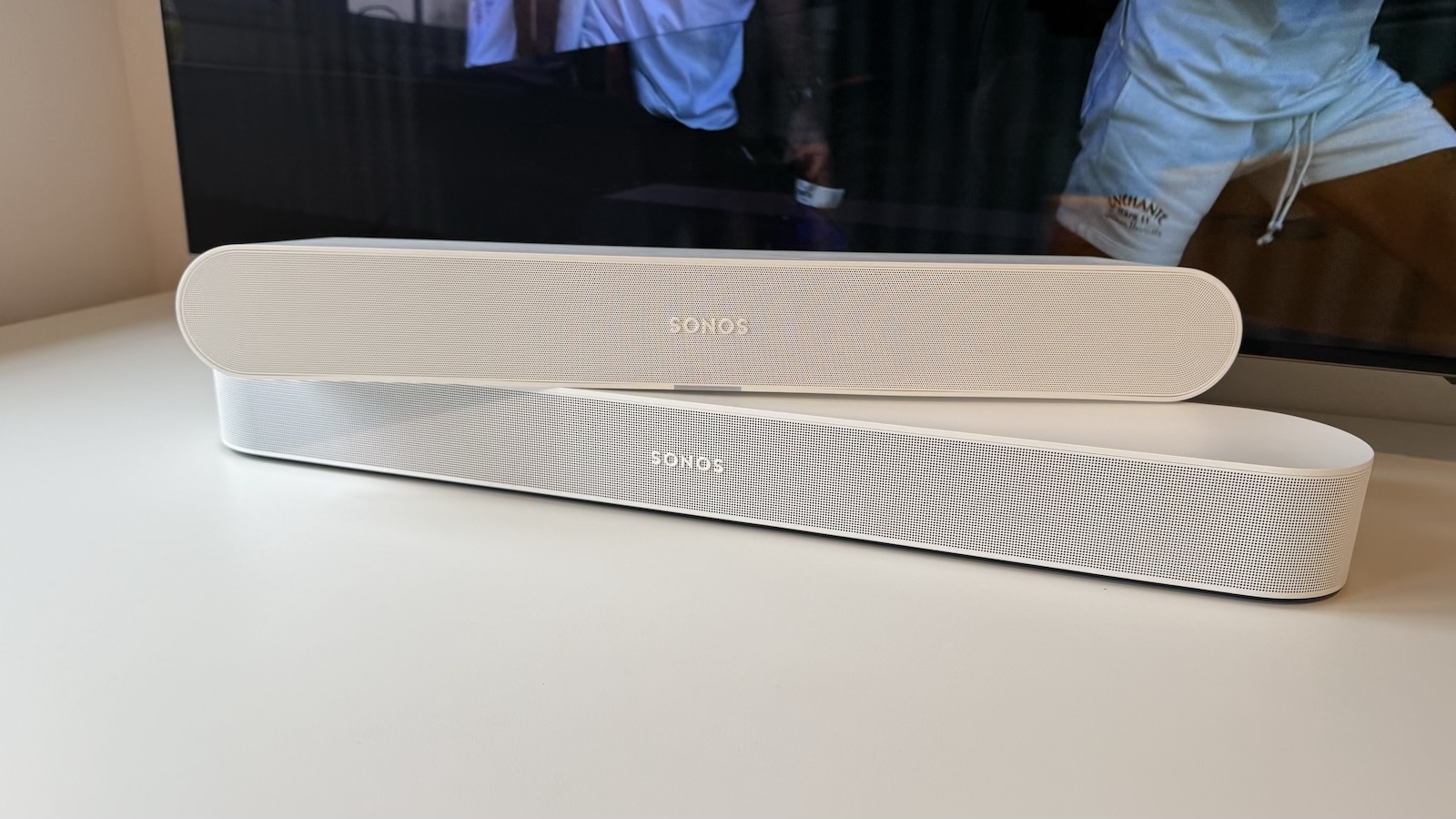
Occasionally we find that certain atmospheric effects, such as the sound of the rain on the caravan's roof, produce phase artefacts that result in a synthetic, almost robotic sound. This phasing occurs a number of times during our testing, both when streaming (with Ted Lasso on Apple TV+) or watching Freeview TV (with Later…With Jools Holland on BBC 2 HD), when the Ray is trying to project background sounds with short reflections, such as crowds and applause. However, we don’t hear it at all when using Blu-ray discs, and given that it’s generally relatively quiet it may not bother most people.
At launch, the Sonos Ray had a significant flaw in its bass presentation that resulted in an unusual low-frequency resonant buzz across a range of movies and music. After we approached Sonos with our concerns, the company confirmed to us that it was able to recreate the issue and has since corrected it via a retroactive firmware update that dips frequencies below 50Hz in line with increases in overall volume level.
Watching chapter 2 of Blade Runner 2049 on Blu-ray, since the update, there is plenty of attack as the Ray recreates the pulsating Vangelis-inspired score. While the Ray does delve deep for a small speaker, it understandably has a light but well-controlled low end. The weighty drums and pulses underneath K’s flight of course don't have the cinematic weight that a sub or a larger soundbar such as the Sony HT-A7000 can produce, but they are well represented with decent dynamic depth. Only once do we hear a touch of bass distortion in the opening credits sequence as the Columbia Pictures logo appears, a moment that most TV speakers would also struggle to cope with.
Swapping to music, we start by streaming Slap That Bass by Ella Fitzgerald. Despite its size, the Ray renders the darting pizzicato line of the double bass with commendable elastic fluidity. This roomy track begins as a nonchalant trio before crescendoing into a big brassy orchestra, and the dynamic build is handled well for such a small speaker, easily filling a large room without becoming harsh.
With the more aggressive Trials Of The Past by SBTRKT, on the whole, the Ray controls the more assertive low end of this track well, if a little clinically. There’s a touch of brittleness to the treble of the interlocking percussive elements, but the arrangement skips along nicely with plenty of intimacy and presence in the vocal.
It’s clear from its promo photography that Sonos is keen to present the Ray as an option for those looking to enhance their gaming audio and, taking Forza Horizon 5 for a spin, we can see why. The Ray has a punchy, snappy and lively delivery that's well suited to gameplay, and there’s just enough low-end to add some grunt to engine noises as well as a distinction between different vehicles.
Verdict

Sophisticated, small, affordable soundbars may as well be unicorns, so unlikely are you to come across one. Although manufacturers are developing increasingly clever techniques to wring every possible frequency out of drivers smaller than a teacup, inevitably, there will always be sonic concessions that have to be made.
In our initial review of the Ray, we felt that there were a few too many compromises, specifically in its bass handling, resulting in an unusual low-frequency resonant buzz across a range of movies and music. However, since an update in July 2022, that problem has now been widely alleviated and, as such, we have upped our initial verdict from three stars to four.
It may not be the warmest or most cinematic sounding speaker, but the Sonos Ray is very capable and, most importantly, is an accessible way to boost your TV sound, competently addressing the single biggest concern most users have: dialogue intelligibility.
While having Dolby Atmos sound in your living room can be fantastic, it’s not of huge concern to the majority of TV viewers. Sonos knows that most people don’t watch immersive content and so the company has instead focused on producing a practical 'bar capable of delivering a clear, punchy sound without all the frills, and in this respect the Ray delivers as one of the best budget soundbars.
Review first published: August 2022. Last updated: March 2025.
SCORES
- Build 4
- Sound 4
- Features 4
Also consider
Sonos Beam Gen 2
If you can stretch your budget a bit further, the Beam Gen 2 is a significant step up over the Ray. It has HDMI eARC, Dolby Atmos, and a warmer, more spacious and altogether more cinematic audio performance. Discounts are fairly common, so bide your time and you may not have to pay significantly more than you would for the Ray.
Sony HT-S2000
While it officially costs more than the Sonos Ray, the Sony HT-S2000 is usually available for very similar money – and it's the better soundbar. It offers Dolby Atmos and DTS:X processing, an HDMI eARC connection and a bigger, more dynamic sonic presentation. It doesn't have the music streaming smarts of a Sonos soundbar, though.
MORE:
Read our review of the Sonos Beam Gen 2
Also consider the Majority Sierra Plus
Our pick of the Best soundbars: budget to premium
5 mistakes everyone makes with Sonos soundbars
What Hi-Fi?, founded in 1976, is the world's leading independent guide to buying and owning hi-fi and home entertainment products. Our comprehensive tests help you buy the very best for your money, with our advice sections giving you step-by-step information on how to get even more from your music and movies. Everything is tested by our dedicated team of in-house reviewers in our custom-built test rooms in London, Reading and Bath. Our coveted five-star rating and Awards are recognised all over the world as the ultimate seal of approval, so you can buy with absolute confidence.
You must confirm your public display name before commenting
Please logout and then login again, you will then be prompted to enter your display name.

